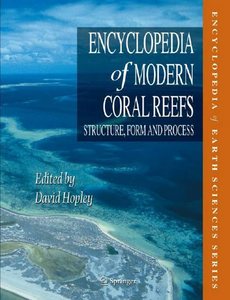Binding organisms
Wust, Raphael A.J. (2011) Binding organisms. In: Hopley, David, (ed.) Encyclopedia of Modern Coral Reefs: structure, form and process. Encyclopedia of Earth Science . Springer, Dordrecht, The Netherlands, pp. 136-139.
![[img]](https://researchonline.jcu.edu.au/19068/5.hassmallThumbnailVersion/19068_Wust_2011_Book_Cover.jpg)
|
Image (JPEG) (Book Cover)
- Cover Image
Download (95kB) |
|
|
PDF (Published Version)
- Published Version
Restricted to Repository staff only |
Abstract
Definition and introduction Coral reef environments host many organisms that actively precipitate mineral matter and encrust or bind sedimentary particles together. In reef systems, waves, storms, and boring organisms constantly produce loose material (mostly skeletal debris), but reef organisms often need firm substrates on which to settle. Binding and encrusting organisms such as encrusting sponges (Knott et al., 2006; Turon et al., 1998), foraminifers (Machado and Moraes, 2002; Perrin, 2009), or algae stabilize the loose carbonate grains and thus cement the reef body. The most important encrusting organisms of modern reefs are the light-dependent calcareous red algae (known also as coralline algae), but many other calcareous encrusting organisms exist including polychaetes, phoronid worms, chaetognaths (arrow worms), holothurianschordates (ascidians), foraminifera, corals, bivalves, algae, and bryozoans. These organisms bind sedimentary particles to create a living framework or shelter or the binding process is purely a by-product of the organisms' digestion and scavenging of the sedimentary environment for food. Although in most modern reefal environments, binding organisms are in the minority, they were responsible for building entire bioherms or reef systems in the geological past and thus during certain eras, binding organisms were much more widespread and common than today. However, even in modern times, binding organisms are critically important as they contribute calcium carbonates to the reef framework (Bianchi et al., 1995; Logan, 1961; Mallela, 2007; Perry, 2000), bind particles and rubble and thus stabilize the substrate (Fischer et al., 2000; Krasnow and Taghon, 1997; Rasmussen et al., 1993; Rasser and Riegl, 2002), and promote larval recruits and offer nutrients and habitats for other species such as bacteria, algae, and foraminifera (Davies et al., 1992, 1998; Maneveldt et al., 2006; Riemann and Helmke, 2002).
Duration of binding depends on several factors and few data are available. Preliminary stabilization by seagrass, uncalcified algae, or sponges may be rapid due to their fast growth, but these preliminary stabilizations last only 1 month to a few months (Rasser and Riegl, 2002), whilst rigid binding by encrusting coralline algae can take place within seven months. Interlocking of branched coralline algal crusts may take place within a few years, or within 1 year, depending on the growth rates of the particular species. In addition, binding activity that contributes to rapid encrusting and cementation is approximately double in fore-reef settings than in back-reef settings (Perry, 1999; Rasser and Riegl, 2002).
| Item ID: | 19068 |
|---|---|
| Item Type: | Book Chapter (Reference) |
| ISBN: | 978-90-481-2639-2 |
| Date Deposited: | 21 Feb 2012 00:30 |
| FoR Codes: | 04 EARTH SCIENCES > 0406 Physical Geography and Environmental Geoscience > 040601 Geomorphology and Regolith and Landscape Evolution @ 100% |
| SEO Codes: | 97 EXPANDING KNOWLEDGE > 970104 Expanding Knowledge in the Earth Sciences @ 100% |
| Downloads: |
Total: 266 Last 12 Months: 5 |
| More Statistics |



